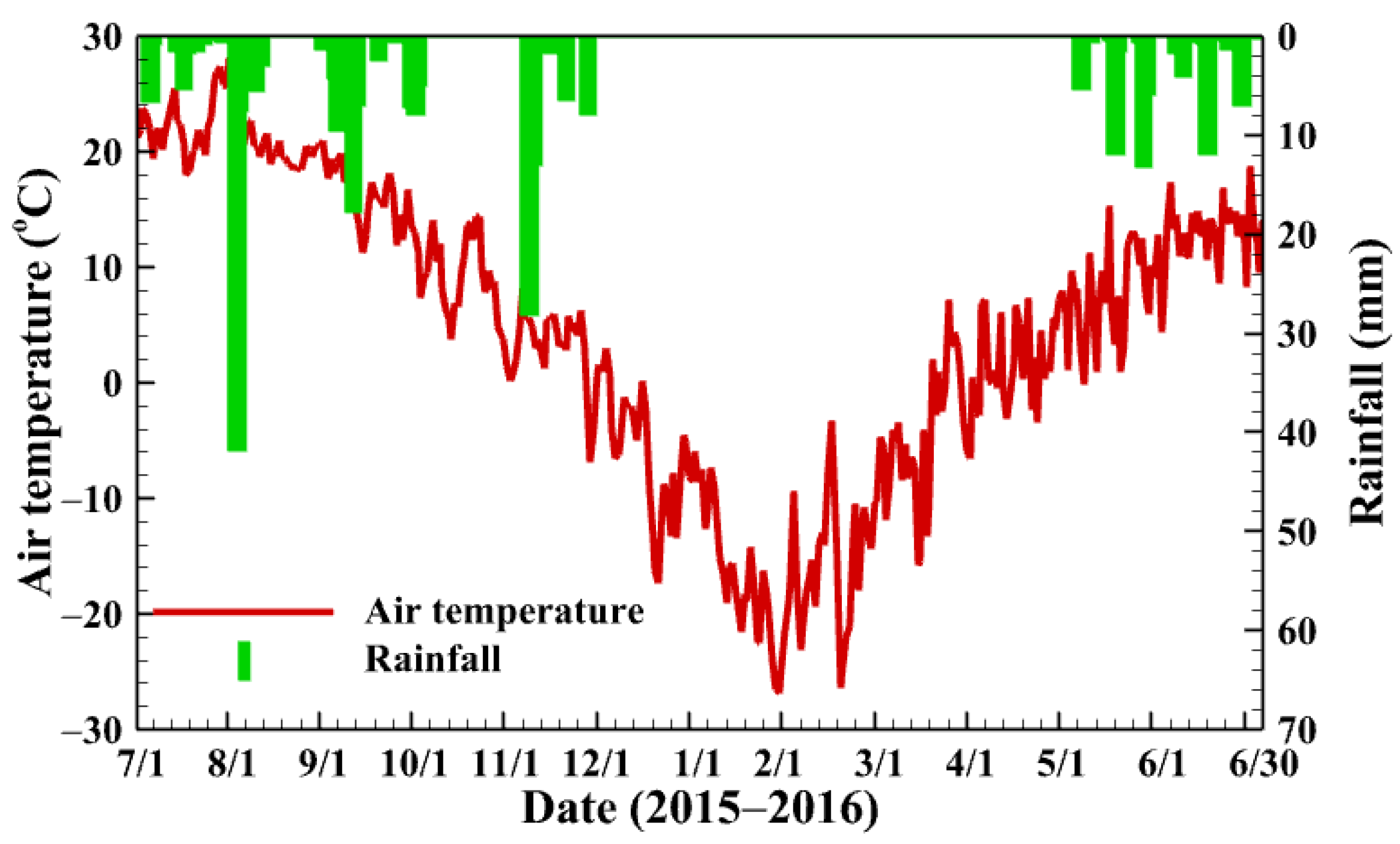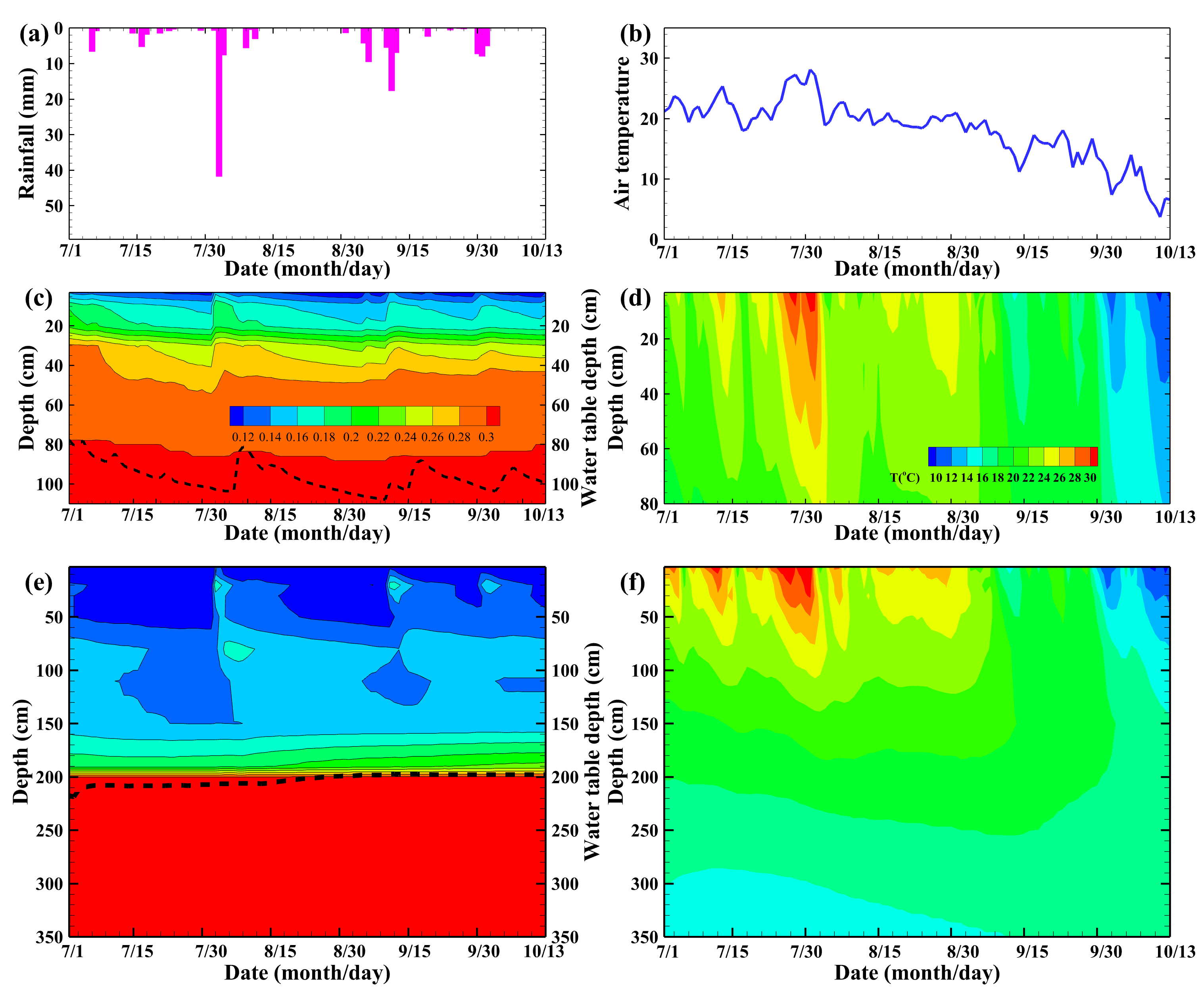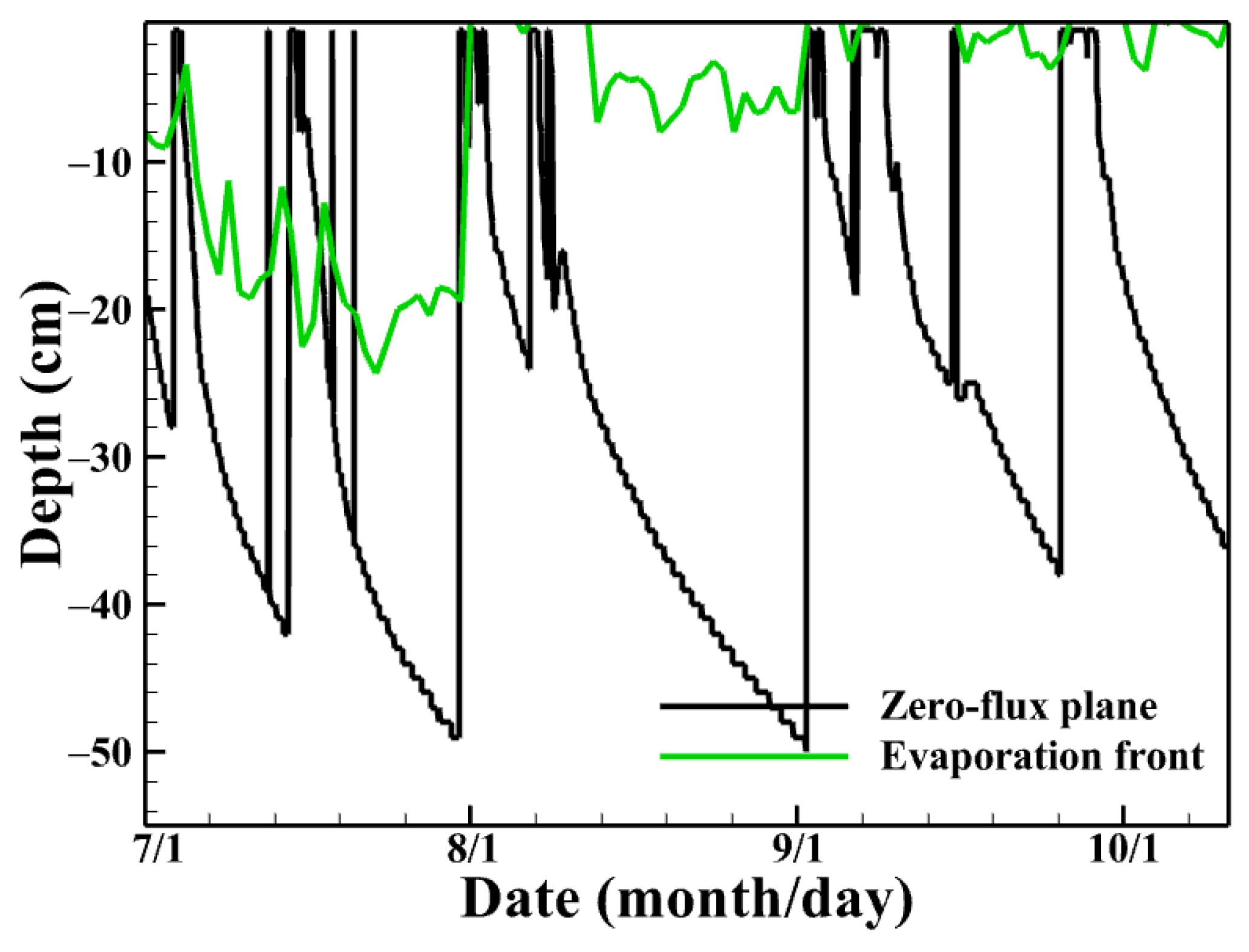Experimental and Numerical Analysis of Evaporation Processes in a Semi-Arid Region
Abstract
1. Introduction
2. Materials and Methods
2.1. Lysimeters
2.2. Date Collection
2.3. Soil Hydraulic Properties
3. Numerical Modeling
3.1. Model Description
3.2. Model Setup
3.3. Model Calibration
3.4. Evaporation Assessment
4. Results
4.1. Observed Results
4.2. Model Calibration and Validation
4.3. Cumulative Evaporation
4.4. Liquid Water and Water Vapor Fluxes
5. Discussion
5.1. Effect of Isothermal and Nonisothermal Models on the Evaporation
5.2. Limitations
6. Conclusions
- (1)
- The cumulative evaporation measured over the experimental period was 24.06 cm and 13.48 cm for lysimeter 1 and 2. The isothermal models underestimated cumulative evaporation by 14.7% and 44.2% for lysimeter 1 and 2. In contrast, the nonisothermal models produced more accurate results, with only 0.95% and overestimation and 5.2% underestimation, respectively.
- (2)
- In lysimeter 1, liquid water flux dominated the evaporation process, driven by pressure head and temperature gradients. In lysimeter 2, water vapor flux played a significant role, especially during nighttime, with condensation processes occurring within the soil profile during the day.
- (3)
- The evaporation front was located at the surface in lysimeter 1, while it was found at a depth of 15–25 cm in lysimeter 2. The zero-flux plane was absent in lysimeter 1 but present at 0–50 cm in lysimeter 2.
- (4)
- The nonisothermal models, which accounted for both liquid and vapor water fluxes, provided more accurate evaporation estimates compared to the isothermal models. This highlights the importance of considering soil temperature and vapor flux in evaporation models, particularly in arid and semi-arid regions.
Author Contributions
Funding
Data Availability Statement
Conflicts of Interest
References
- Good, S.P.; Noone, D.; Bowen, G. Hydrologic connectivity constrains partitioning of global terrestrial water fluxes. Science 2015, 349, 175–177. [Google Scholar] [PubMed]
- Seneviratne, S.I.; Corti, T.; Davin, E.L.; Hirschi, M.; Jaeger, E.B.; Lehner, I.; Orlowsky, B.; Teuling, A.J. Investigating soil moisture–climate interactions in a changing climate: A review. Earth-Sci. Rev. 2010, 99, 125–161. [Google Scholar] [CrossRef]
- Kahil, M.T.; Dinar, A.; Albiac, J. Modeling water scarcity and droughts for policy adaptation to climate change in arid and semiarid regions. J. Hydrol. 2015, 522, 95–109. [Google Scholar] [CrossRef]
- Shoba, P.; Ramakrishnan, S.S. Modeling the contributing factors of desertification and evaluating their relationships to the soil degradation process through geomatic techniques. Solid Earth 2016, 7, 341–354. [Google Scholar]
- Allan, R.P.; Barlow, M.; Byrne, M.P.; Cherchi, A.; Douville, H.; Fowler, H.J.; Gan, T.Y.; Pendergrass, A.G.; Rosenfeld, D.; Swann, A.L. Advances in understanding large-scale responses of the water cycle to climate change. Ann. N. Y. Acad. Sci. 2020, 1472, 49–75. [Google Scholar] [PubMed]
- Gong, C.; Wang, W.; Zhang, Z.; Wang, H.; Luo, J.; Brunner, P. Comparison of field methods for estimating evaporation from bare soil using lysimeters in a semi-arid area. J. Hydrol. 2020, 590, 125334. [Google Scholar]
- Sakai, M.; Jones, S.B.; Tuller, M. Numerical evaluation of subsurface soil water evaporation derived from sensible heat balance. Water Resour. Res. 2011, 47, W02547. [Google Scholar]
- Smits, K.M.; Ngo, V.V.; Cihan, A.; Sakaki, T.; Illangasekare, T.H. An evaluation of models of bare soil evaporation formulated with different land surface boundary conditions and assumptions. Water Resour. Res. 2012, 48, W12522. [Google Scholar] [CrossRef]
- Veihmeyer, F.J.; Brooks, F.A. Measurements of cumulative evaporation from bare soil. Eos Trans. Am. Geophys. Union 1954, 35, 601–607. [Google Scholar]
- Gardner, W.R.; Fireman, M. Laboratory studies of evaporation from soil columns in the presence of a water table. Soil Sci. 1958, 85, 244–249. [Google Scholar] [CrossRef]
- Shih, S.F. Soil surface evaporation and water table depths. J. Irrig. Drain. Eng. ASCE 1983, 109, 366–376. [Google Scholar]
- Hellwig, D.H.R. Evaporation of water from sand, 4: The influence of the depth of the water-table and the particle size distribution of the sand. J. Hydrol. 1973, 18, 317–327. [Google Scholar] [CrossRef]
- Coudrain-Ribstein, A.; Pratx, B.; Talbi, A.; Jusserand, C. Is the evaporation from phreatic aquifers in arid zones independent of the soil characteristics? C. R. L’acad. Sci.—Ser. IIA—Earth Planet. Sci. 1998, 326, 159–165. [Google Scholar]
- Warrick, A.W.; Yitayew, M. Trickle lateral hydraulics. I: Analytical solution. J. Irrig. Drain. Eng. ASCE 1988, 114, 281–288. [Google Scholar] [CrossRef]
- Shokri, N.; Salvucci, G.D. Evaporation from porous media in the presence of a water table. Vadose Zone J. 2011, 10, 1309–1318. [Google Scholar] [CrossRef]
- Yang, G.; Xu, R.; Tian, Y.; Guo, S.; Wu, J.; Chu, X. Data-driven methods for flow and transport in porous media: A review. Int. J. Heat Mass Transf. 2024, 235, 126149. [Google Scholar]
- Yonaba, R.; Kiema, A.; Tazen, F.; Belemtougri, A.; Cissé, M.; Mounirou, L.A.; Bodian, A.; Koïta, M.; Karambiri, H. Accuracy and interpretability of machine learning-based approaches for daily ETo estimation under semi-arid climate in the West African Sahel. Earth Sci. Inform. 2025, 18, 87. [Google Scholar] [CrossRef]
- Eshetu, K.D.; Alamirew, T.; Woldesenbet, T.A. Interpretable machine learning for predicting evaporation from awash reservoirs, Ethiopia. Earth Sci. Inform. 2023, 16, 3209–3226. [Google Scholar] [CrossRef]
- Rose, D.; Konukcu, F.; Gowing, J. Effect of watertable depth on evaporation and salt accumulation from saline groundwater. Aust. J. Soil Res. 2005, 43, 565–573. [Google Scholar]
- Gowing, J.W.; Konukcu, F.; Rose, D.A. Evaporative flux from a shallow watertable: The influence of a vapour–liquid phase transition. J. Hydrol. 2006, 321, 77–89. [Google Scholar]
- Wang, W.; Zhao, G.; Li, J.; Hou, L.; Li, Y.; Yang, F. Experimental and numerical study of coupled flow and heat transport. Proc. Inst. Civ. Eng.—Water Manag. 2011, 164, 533–547. [Google Scholar]
- Wang, W.; Zhang, Z.; Yeh, T.-c.J.; Qiao, G.; Wang, W.; Duan, L.; Huang, S.-Y.; Wen, J.-C. Flow dynamics in vadose zones with and without vegetation in an arid region. Adv. Water Resour. 2017, 106, 68–79. [Google Scholar]
- Goss, K.-U.; Madliger, M. Estimation of water transport based on in situ measurements of relative humidity and temperature in a dry Tanzanian soil. Water Resour. Res. 2007, 43, W05433. [Google Scholar]
- D’Odorico, P.; Bhattachan, A.; Davis, K.F.; Ravi, S.; Runyan, C.W. Global desertification: Drivers and feedbacks. Adv. Water Resour. 2013, 51, 326–344. [Google Scholar]
- Dong, X.; Zhang, X. Some observations of the adaptations of sandy shrubs to the arid environment in the Mu US Sandland: Leaf water relations and anatomic features. J. Arid. Environ. 2001, 48, 41–48. [Google Scholar]
- Huang, J.; Zhou, Y.; Hou, R.; Wenninger, J. Simulation of water use dynamics by Salix bush in a semiarid shallow groundwater area of the Chinese Erdos Plateau. Water 2015, 7, 6999–7021. [Google Scholar] [CrossRef]
- Yin, L.; Zhou, Y.; Huang, J.; Wenninger, J.; Zhang, E.; Hou, G.; Dong, J. Interaction between groundwater and trees in an arid site: Potential impacts of climate variation and groundwater abstraction on trees. J. Hydrol. 2015, 528, 435–448. [Google Scholar]
- Gao, N.; Liang, W.; Gou, F.; Liu, Y.; Fu, B.; Lü, Y. Assessing the impact of agriculture, coal mining, and ecological restoration on water sustainability in the Mu US Sandyland. Sci. Total Environ. 2024, 929, 172513. [Google Scholar]
- Zhang, Z.; Wang, W.; Wang, Z.; Chen, L.; Gong, C. Evaporation from bare ground with different water-table depths based on an in-situ experiment in Ordos Plateau, China. Hydrogeol. J. 2018, 26, 1683–1691. [Google Scholar]
- Van Genuchten, M. A closed-form equation for predicting the hydraulic conductivity of unsaturated soils. Soil Sci. Soc. Am. J. 1980, 44, 892–898. [Google Scholar]
- Lai, J.; Ren, L. Assessing the size dependency of measured hydraulic conductivity using double-ring infiltrometers and numerical simulation. Soil Sci. Soc. Am. J. 2007, 71, 1667–1675. [Google Scholar] [CrossRef]
- Simunek, J.J.; Šejna, M.; Saito, H.; Sakai, M.; Van Genuchten, M. The HYDRUS-1D Software Package for Simulating the Movement of Water, Heat, and Multiple Solutes in Variably Saturated Media; Version 4.17; University of California Riverside: Riverside, CA, USA, 2013. [Google Scholar]
- Saito, H.; Šimůnek, J.; Mohanty, B.P. Numerical analysis of coupled water, vapor, and heat transport in the vadose zone. Vadose Zone J. 2006, 5, 784–800. [Google Scholar] [CrossRef]
- Marsily, G.D. Quantitative Hydrogeology: Groundwater Hydrology for Engineers; Academic Press: Cambridge, MA, USA, 1986. [Google Scholar]
- Chung, S.O.; Horton, R. Soil heat and water flow with a partial surface mulch. Water Resour. Res. 1987, 23, 2175–2186. [Google Scholar] [CrossRef]
- Cortés, V.B.F. Sar Effects on Evaporation Fluxes from Shallow Groundwater. Master’s Thesis, Pontificia Universidad Catolica de Chile, Santiago, Chile, 2015. [Google Scholar]
- Camillo, P.J.; Gurney, R.J. A resistance parameter for bare-soil evaporation models. Soil Sci. 1986, 141, 95–105. [Google Scholar] [CrossRef]
- Hou, L.; Wang, X.-S.; Hu, B.X.; Shang, J.; Wan, L. Experimental and numerical investigations of soil water balance at the hinterland of the Badain Jaran desert for groundwater recharge estimation. J. Hydrol. 2016, 540, 386–396. [Google Scholar] [CrossRef]
- Bittelli, M.; Ventura, F.; Campbell, G.S.; Snyder, R.L.; Gallegati, F.; Pisa, P.R. Coupling of heat, water vapor, and liquid water fluxes to compute evaporation in bare soils. J. Hydrol. 2008, 362, 191–205. [Google Scholar] [CrossRef]
- Han, J.; Zhou, Z.; Fu, Z.; Wang, J. Evaluating the impact of nonisothermal flow on vadose zone processes in presence of a water table. Soil Sci. 2014, 179, 57–67. [Google Scholar] [CrossRef]
- Saito, H.; Šimůnek, J. Effects of meteorological models on the solution of the surface energy balance and soil temperature variations in bare soils. J. Hydrol. 2009, 373, 545–561. [Google Scholar] [CrossRef]
- Hernández-López, M.F.; Braud, I.; Gironás, J.; Suárez, F.; Muñoz, J.F. Modelling evaporation processes in soils from the Huasco salt flat basin, Chile. Hydrol. Process. 2016, 30, 4704–4719. [Google Scholar] [CrossRef]
- Hernández-López, M.F.; Gironás, J.; Braud, I.; Suárez, F.; Muñoz, J.F. Assessment of evaporation and water fluxes in a column of dry saline soil subject to different water table levels. Hydrol. Process. 2014, 28, 3655–3669. [Google Scholar] [CrossRef]
- Zhang, Z.; Wang, W.; Gong, C.; Zhao, M.; Wang, Z.; Ma, H. Effects of non-isothermal flow on groundwater recharge in a semi-arid region. Hydrogeol. J. 2021, 29, 541–549. [Google Scholar] [CrossRef]
- Liu, T.; Liu, L.; Luo, Y.; Lai, J. Simulation of groundwater evaporation and groundwater depth using swat in the irrigation district with shallow water table. Environ. Earth Sci. 2015, 74, 315–324. [Google Scholar] [CrossRef]
- Ortega-Farias, S.O.; Olioso, A.; Fuentes, S.; Valdes, H. Latent heat flux over a furrow-irrigated tomato crop using penman–monteith equation with a variable surface canopy resistance. Agric. Water Manag. 2006, 82, 421–432. [Google Scholar] [CrossRef]
- Zhang, B.; Kang, S.; Li, F.; Zhang, L. Comparison of three evapotranspiration models to Bowen ratio-energy balance method for a vineyard in an arid desert region of northwest China. Agric. For. Meteorol. 2008, 148, 1629–1640. [Google Scholar] [CrossRef]
- Cheng, Y.; Zhan, H.; Yang, W.; Dang, H.; Li, W. Is annual recharge coefficient a valid concept in arid and semi-arid regions? Hydrol. Earth Syst. Sci. 2017, 21, 5031–5042. [Google Scholar] [CrossRef]
- Scanlon, B.R.; Milly, P.C.D. Water and heat fluxes in desert soils: 2. Numerical simulations. Water Resour. Res. 1994, 30, 721–733. [Google Scholar] [CrossRef]
- Jiménez-Martínez, J.; Skaggs, T.H.; van Genuchten, M.T.; Candela, L. A root zone modelling approach to estimating groundwater recharge from irrigated areas. J. Hydrol. 2009, 367, 138–149. [Google Scholar] [CrossRef]











(cm3/cm3) | (cm3/cm3) | (cm−1) | (-) | (cm/h) |
|---|---|---|---|---|
| 0.015 | 0.31 | 0.020 | 4.84 | 4.6 |
| Lysimeter 1 | Hydraulic Parameters | Thermal Conductivity | ||||||
|---|---|---|---|---|---|---|---|---|
| Soil Depths (cm) | ||||||||
| (cm3/cm3) | (cm3/cm3) | (cm−1) | (-) | (cm/h) | (Wcm−1 °C−1) | (W cm−1 °C−1) | (W cm−1 °C−1) | |
| 0–5 | 0.024 | 0.25 | 0.02 | 2.14 | 0.2 | 214.3 | 428.7 | 1821.8 |
| 6–25 | 0.021 | 0.304 | 0.016 | 2.6 | 1.72 | 242.2 | 392.2 | 1714.7 |
| 26–65 | 0.03 | 0.323 | 0.012 | 2.42 | 6.4 | 278.6 | 450.1 | 1736.1 |
| 66–100 | 0.02 | 0.31 | 0.014 | 2.3 | 2.5 | 300.1 | 429.4 | 1760.3 |
| Lysimeter 2 | Hydraulic Parameters | Thermal Conductivity | ||||||
|---|---|---|---|---|---|---|---|---|
| Soil Depths (cm) | ||||||||
| (cm3/cm3) | (cm3/cm3) | (cm−1) | (-) | (cm/h) | (Wcm−1 °C−1) | (Wcm−1 °C−1) | (Wcm−1 °C−1) | |
| 0–5 | 0.008 | 0.309 | 0.03 | 1.8 | 0.8 | 24.2 | 392.2 | 1714.7 |
| 6–100 | 0.01 | 0.309 | 0.018 | 2.05 | 0.4 | 240.1 | 350.1 | 1612.4 |
| 101–400 | 0.01 | 0.28 | 0.03 | 1.8 | 0.6 | 50.9 | 420.0 | 1800.1 |
Disclaimer/Publisher’s Note: The statements, opinions and data contained in all publications are solely those of the individual author(s) and contributor(s) and not of MDPI and/or the editor(s). MDPI and/or the editor(s) disclaim responsibility for any injury to people or property resulting from any ideas, methods, instructions or products referred to in the content. |
© 2025 by the authors. Licensee MDPI, Basel, Switzerland. This article is an open access article distributed under the terms and conditions of the Creative Commons Attribution (CC BY) license (https://creativecommons.org/licenses/by/4.0/).
Share and Cite
Zhang, X.; Zhang, Z.; Wang, W.; Wang, Z. Experimental and Numerical Analysis of Evaporation Processes in a Semi-Arid Region. Water 2025, 17, 1113. https://doi.org/10.3390/w17081113
Zhang X, Zhang Z, Wang W, Wang Z. Experimental and Numerical Analysis of Evaporation Processes in a Semi-Arid Region. Water. 2025; 17(8):1113. https://doi.org/10.3390/w17081113
Chicago/Turabian StyleZhang, Xuanming, Zaiyong Zhang, Wenke Wang, and Zhoufeng Wang. 2025. "Experimental and Numerical Analysis of Evaporation Processes in a Semi-Arid Region" Water 17, no. 8: 1113. https://doi.org/10.3390/w17081113
APA StyleZhang, X., Zhang, Z., Wang, W., & Wang, Z. (2025). Experimental and Numerical Analysis of Evaporation Processes in a Semi-Arid Region. Water, 17(8), 1113. https://doi.org/10.3390/w17081113






